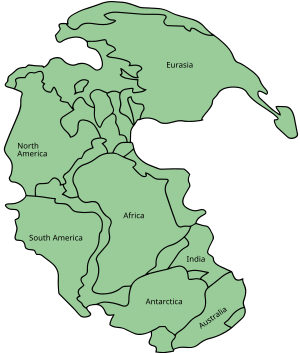Pangaea facts for kids

Pangaea was a huge "supercontinent" that existed a very long time ago. Imagine all the continents we know today, like North America, Africa, and Asia, joined together into one giant landmass!
This amazing process started about 450 million years ago and finished around 210 million years ago. Pangaea wasn't the first supercontinent, but it was the most recent one to form before our current continents. Supercontinents form because of something called plate tectonics, which is how Earth's giant land plates move around.
How Pangaea Formed
Pangaea formed when different continental plates slowly crashed into each other. These collisions were incredibly powerful. They created some of the biggest mountain ranges Earth has ever seen!
For example, the Caledonian orogeny and the Alleghenian orogeny were huge mountain-building events. Today, the low mountains in Scotland, Scandinavia, and eastern North America (like the Appalachian Mountains) are what's left of these ancient, massive ranges. They have been worn down over millions of years.
How Pangaea Broke Apart
Pangaea didn't stay together forever. It started to break apart about 180 to 200 million years ago, during the early to middle Jurassic period. This break-up happened in three main stages.
First, Pangaea split into two big supercontinents: Laurasia in the north and Gondwana in the south. A giant crack, or "rift," formed between them, which eventually became the North Atlantic Ocean.
The second big stage of the break-up happened around 150–140 million years ago. This is when Gondwana, the southern supercontinent, started to split into many pieces. These pieces became the continents we know today as Africa, South America, India, Antarctica, and Australia.
The third and final main stage of the break-up happened more recently, about 60–55 million years ago. Laurasia, the northern supercontinent, also split. North America (which included Greenland at the time) separated from Eurasia. This created the Norwegian Sea. As the Atlantic and Indian Oceans continued to grow, another ancient ocean called the Tethys Ocean slowly closed up.
Even today, the Earth's plates are still moving. You can see the break-up of Pangaea continuing in places like the Great Rift Valley in East Africa and the Arabian Peninsula.
Images for kids
-
The Appalachian Mountains in North America are remnants of mountains formed when Pangaea came together.
-
An early Triassic Lystrosaurus fossil found in South Africa. Similar fossils have been found on other continents, supporting the idea of Pangaea.
See also
 In Spanish: Pangea para niños
In Spanish: Pangea para niños










